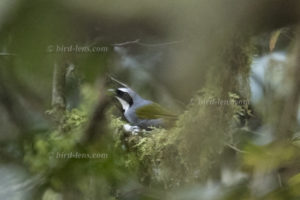 A fresh, sunny morning in the Bakossi Mountains. The initial stretches of the trail are even for a fairly distance, getting steeper and even insanely steep inside the core primary forest. The last patch we did inside primary forest before getting to one of the territorial spots of the Serle’s Bushshrike – better known as Mount Kupe Bushshrike (Telophorus kupeensis), we did not see especially many birds. It was a fairly quiet forest. Finally, we have found a territorial pair of Serle’s Bushshrike or Mount Kupe Bushshrike. The birds are even quite low to detect inside the forest – almost just above the undergrowth. We pass lianas and fallen tree trunks and then stand just below the top of a ridge. A little further down the slope, a couple of the Serle’s Bushshrike (Mount Kupe Bushshrike) cling to twigs and branches in a not too dense, but mossy and lichen-covered undergrowth. It is very similar to the habitat description “Primary forest with relatively open understorey, sometimes on steep hillsides; at 930-1550 m “, which is described in the Handbook of the Birds of the World Alive. Lynx Editions, Barcelona.
A fresh, sunny morning in the Bakossi Mountains. The initial stretches of the trail are even for a fairly distance, getting steeper and even insanely steep inside the core primary forest. The last patch we did inside primary forest before getting to one of the territorial spots of the Serle’s Bushshrike – better known as Mount Kupe Bushshrike (Telophorus kupeensis), we did not see especially many birds. It was a fairly quiet forest. Finally, we have found a territorial pair of Serle’s Bushshrike or Mount Kupe Bushshrike. The birds are even quite low to detect inside the forest – almost just above the undergrowth. We pass lianas and fallen tree trunks and then stand just below the top of a ridge. A little further down the slope, a couple of the Serle’s Bushshrike (Mount Kupe Bushshrike) cling to twigs and branches in a not too dense, but mossy and lichen-covered undergrowth. It is very similar to the habitat description “Primary forest with relatively open understorey, sometimes on steep hillsides; at 930-1550 m “, which is described in the Handbook of the Birds of the World Alive. Lynx Editions, Barcelona.
Obviously, the two birds have chosen a special place and perform something like a dance, which is only known to a few ornithologists and is very observable. Definitely a mating display; a reminiscence to the leks of the Band-tailed Manakin (Pipra fasciicauda). In the course of this “dance,” one individual of the Serle’s Bushshrike hops up a moss-covered branch in the undergrowth, and its partner follows, expelling rough nasal sounds. Then one of them jumps down the same branch and the other one follows him on ist foot – in about half a meter distance. Of course, also shouting loudly.
Overall, I spend about 15 minutes on this slope and shoot with the Canon EF 200mm f / 2L IS USM on the Canon EOS 5DS R with 1/160 sec. Later also with 1/80 sec. The images total to 183 images, of which 26 Pictures are acceptable. That was hard work. A big compliment goes to the Canon EF 200mm f / 2L IS USM. The excellent image stabilizer provided shooting out of the hand with 1/80 sec.. Images were still sharp (enough). Camera vibration was the least problem given the many lianas, branches, twigs and leaves which deter focussing. Something out of breath, with a sore hand but overjoyed, we three congratulate each other. Even my guides had not been able to watch the show so well and intensively, it seems to me. The local guide says that we are here in the right month. Between the beginning of February and the middle of March, Mount Kupe Bush-shrikes are the most active. In other months you are lucky if you could even hear them. Also, the time of day fit. We have hit just the right time window. In the morning from 7:00 to 9:00 and in the afternoon from 15:00 to 17:00, the Mount Kupe Bush-shrike is best to discover.
Although the Bakossi Mountains are probably the more reliable site as it holds a healthy population of the restricted and enigmatic Mt. Kupé Bushshrike, Mount Kupé is probably the best known birding site in Cameroon for this bird. The advantage is, that forest below Mount Kupé can be reached on a daily base from Nyasoso. In April 2017 we spent most of the time birding Max’s Trail in a group. The forest provide habitat as a fine pristine mountain rain forest with big trees and lot of epiphytes. We did not succeed with the Mt. Kupé Bushshrike but joined efforts produced goodies as Ayres’s Hawk-Eagle (Hieraaetus ayresii), African Emerald Cuckoo (Chrysococcyx cupreus), Naked-faced Barbet (Gymnobucco calvus), Grey-headed Broadbill (Smithornis sharpei), Fiery-breasted Bushshrike (Malaconotus cruentus), Bates’ Paradise-Flycatcher (Terpsiphone batesi), Golden Greenbul (Calyptocichla serina), Yellow-footed Flycatcher (Muscicapa sethsmithi), Bates’ Sunbird (Cinnyris batesi), Grey-green Bushshrike or Bocage´s Bush-Shrike (Telophorus bocagei), Fernando Po Batis (Batis poensis), Black-capped Woodland-Warbler (Phylloscopus herberti), Banded Prinia (Prinia bairdii), Rufous Flycatcher-Thrush or Fraser´s Rufous Thrush (Neocossyphus fraseri), Preuss’s Weaver (Ploceus preussi) and Woodhouse’s Antpecker (Parmoptila woodhousei). The nice observation of the Fiery-breasted Bushshrike is already described in a different blog. We also birded the adjacent farmbush lower down of the mountain forest and saw a good number of species not found in the forest itself.
To cope with the growing demand for top shots of the rarer species of the Palearctic Bird-Lens is keen to enrich the range of pictures of birds you can find not only in the western palearctic. Beside the image of the blog above you can find a nice selection of birds in the gallery or in the “Pictures Shop” very soon. Just give a message, if Bird-Lens could serve you with an image needed before the new pictures are online.